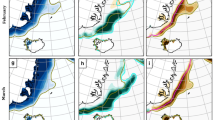Abstract.
The processes leading to the formation of a large anomaly of sea-ice volume integrated over the Northern Hemisphere have been investigated in a coarse-resolution three-dimensional atmosphere–ocean-sea-ice model. This anomaly lasts for about 20 years and reaches 8.6 × 103 km3, i.e. 6 standard deviations. It is associated with a maximum surface cooling of more than 5 °C in the annual mean close to Spitzbergen. The trigger of the large event in the model is a sequence of years presenting an atmospheric circulation characterised by negative geopotential height anomalies over Greenland and positive ones in the Barents and Norwegian seas. This atmospheric anomaly induces an increase in the ice volume as well as of the ice extent. Sea ice survives in the area located close to Spitzbergen where deep convection occurs during normal years. This is associated with a shut down of convection in that area and thus by a strong reduction of the upward heat flux from the ocean to the atmosphere that strongly amplifies the initial cooling. The long sequence of following years presenting the same type of anomaly in the atmosphere is not just a rare realisation of the intrinsic atmospheric variability. A positive feedback between the modification of surface conditions and the atmospheric circulation reinforces the initial atmospheric anomaly. Finally, the large event stops when convection increases again as a result of an increase in ocean surface density close to Spitzbergen. This density increase is due to both the advection of a positive salinity anomaly created in the Arctic because of brine rejection and to local ice formation southward of Spitzbergen during the cold event. Sensitivity experiments performed with the model have shown that the frequency of the events is very sensitive to the mean climate simulated by the model, the frequency being higher in a colder climate.
Similar content being viewed by others
Author information
Authors and Affiliations
Additional information
Electronic Publication
Rights and permissions
About this article
Cite this article
Goosse, .H., Selten, .F., Haarsma, .R. et al. Large sea-ice volume anomalies simulated in a coupled climate model. Climate Dynamics 20, 523–536 (2003). https://doi.org/10.1007/s00382-002-0290-4
Received:
Accepted:
Issue Date:
DOI: https://doi.org/10.1007/s00382-002-0290-4




